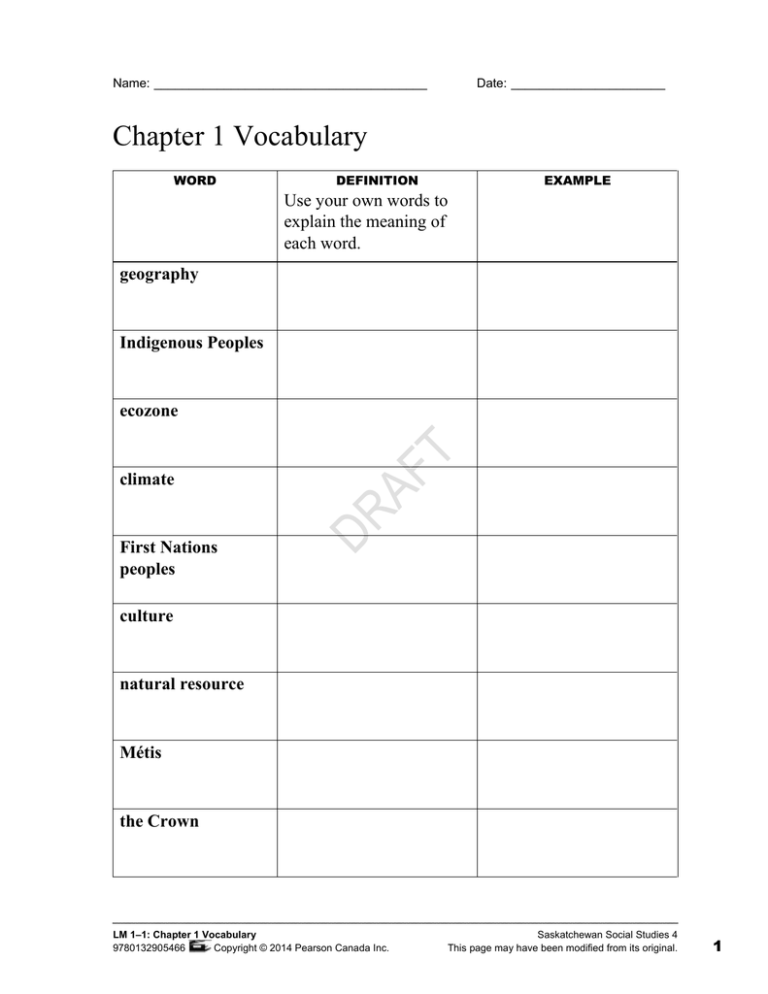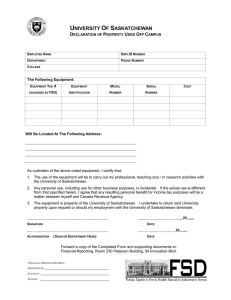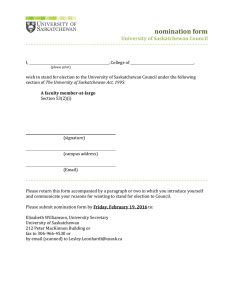Chapter 1 Vocabulary
advertisement

Name: _______________________________________ Date: ______________________ Chapter 1 Vocabulary WORD DEFINITION EXAMPLE Use your own words to explain the meaning of each word. geography Indigenous Peoples ecozone climate First Nations peoples culture natural resource Métis the Crown LM 1–1: Chapter 1 Vocabulary Copyright © 2014 Pearson Canada Inc. 9780132905466 Saskatchewan Social Studies 4 This page may have been modified from its original. 1 Name: _______________________________________ Date: ______________________ Chapter 1 Vocabulary, page 2 WORD DEFINITION EXAMPLE Use your own words to explain the meaning of each word. homestead treaty lifestyle non-renewable resource 2 LM 1–1: Chapter 1 Vocabulary 9780132905466 Copyright © 2014 Pearson Canada Inc. Saskatchewan Social Studies 4 This page may have been modified from its original. Name: _______________________________________ Date: ______________________ Using Maps to Describe Location 1. Choose four communities shown on the map on page 7 of the Student Book and list them in the chart below. 2. Use the compass rose and scale in the map key to describe the locations of the communities you have chosen. Saskatchewan Community Direction from Molanosa Estimated Distance from Molanosa Explain how you made your estimates: LM 1–2: Using Maps to Describe Location Copyright © 2014 Pearson Canada Inc. 9780132905466 Saskatchewan Social Studies 4 This page may have been modified from its original. 3 Name: _______________________________________ Date: ______________________ Exploring Saskatchewan’s Ecozones Describe the geographic features of each ecozone. NATURAL VEGETATION LANDFORMS AND WATER CLIMATE WILDLIFE TAIGA SHIELD BOREAL SHIELD BOREAL PLAIN PRAIRIE 4 LM 1–3: Exploring Saskatchewan’s Ecozones 9780132905466 Copyright © 2014 Pearson Canada Inc. Saskatchewan Social Studies 4 This page may have been modified from its original. Name: _______________________________________ Date: ______________________ Living in Saskatchewan’s Ecozones What are the benefits and challenges of living in each of Saskatchewan’s ecozones? Use the chart below to record your ideas and list the clues you find in the text. What conclusions can you draw? Taiga Shield Boreal Shield Boreal Plain Prairie Possible Benefit Possible Challenge Clues and conclusions Clues and conclusions Possible Benefit Possible Challenge Clues and conclusions Clues and conclusions Possible Benefit Possible Challenge Clues and conclusions Clues and conclusions Possible Benefit Possible Challenge Clues and conclusions Clues and conclusions LM 1–4: Living in Saskatchewan’s Ecozones Copyright © 2014 Pearson Canada Inc. 9780132905466 Saskatchewan Social Studies 4 This page may have been modified from its original. 5 Name: _______________________________________ Date: ______________________ Geography and Lifestyle Use this table to record evidence of how each feature of geography (column headings) influences each element of lifestyle (row headings). Based on the evidence you have gathered, which geographic features seem to influence lifestyle the most? Which appear to influence it the least? LOCATION LANDFORMS CLIMATE POPULATION Food Clothing Shelter Transportation Education Work Recreation 6 LM 1–5: Geography and Lifestyle 9780132905466 Copyright © 2014 Pearson Canada Inc. Saskatchewan Social Studies 4 This page may have been modified from its original. Name: _______________________________________ Date: ______________________ Saskatchewan Architecture Find three examples of Saskatchewan architecture that show a connection between the land and the people or their culture. Use this table to record your notes so you can refer to them when you share what you have found with the class. Check with your teacher for a list of Internet sites where you can begin your research. EXAMPLE NOTES Name: Location of structure: URL: Description: (What is/was the structure used for? Who used it? How old is it? How would you describe the structure?) Connection to the land or culture: Name: Location of structure: URL: Description: (What is/was the structure used for? Who used it? How old is it? How would you describe the structure?) Connection to the land or culture: Name: Location of structure: URL: Description: (What is/was the structure used for? Who used it? How old is it? How would you describe the structure?) Connection to the land or culture: LM 1–6: Saskatchewan Architecture Copyright © 2014 Pearson Canada Inc. 9780132905466 Saskatchewan Social Studies 4 This page may have been modified from its original. 7 Chapter 1 Line Master Answer Key LM 1–1: Chapter 1 Vocabulary Answers will vary. Suggested answers: geography: the study of Earth’s surface, climate, and natural resources, and how people interact with those features Indigenous Peoples: the first peoples who lived on the land and their descendants (example: First Nations peoples, Inuit, and Métis) ecozone: a region that has particular features, such as landforms, plants, animals, and climate (example: Taiga Shield) climate: the type of weather that is usual or normal for an area over a long period of time (example: the Boreal Shield has long, cold winters and short cool summers) First Nations peoples: original peoples who lived in Canada (example: Denesųłiné) culture: how a group of people live together; includes language, beliefs, food, and art (example: First Nations peoples each have their own language and traditions) natural resource: something from nature that is useful to us (example: water) Métis: descendants of First Nations peoples and Europeans (example: Douglas Cardinal) the Crown: refers to the king or queen, but might also mean the Canadian government (example: Queen Elizabeth II) homestead: land that was given to newcomers for farming (example: n/a, although some students may live on a former homestead or know people who do) treaty: an agreement between two or more nations that describes how they will get along (example: some students may note the Treaty area in which they live) lifestyle: the way we live; it shows our culture and beliefs and is influenced by where we live (example: many people in northern Saskatchewan fish and hunt for food) non-renewable resource: a resource from nature that cannot be replaced once it is gone (example: oil) LM 1–2: Using Maps to Describe Location Answers will vary depending on the locations selected and estimation methods used. 8 Saskatchewan Social Studies 4 ©P LM 1–3: Exploring Saskatchewan’s Ecozones Taiga Shield Natural Vegetation: Shrubs, lichens, jack pine, white spruce, birch Landforms and Water: Rocky with low, rolling hills Climate: Long, cold winters; short, cool summers Wildlife: Caribou, wolves, snowshoe hares, arctic terns, grouse, arctic grayling Boreal Shield Natural Vegetation: Black spruce, white spruce, jack pine, balsam fir, poplar, birch Landforms and Water: Rolling hills with many lakes and rivers; soil varies from sandy to rocky Climate: Long, cold winters; short, cool summers Wildlife: Black bears, arctic fox, deer, lynx, hawks, loons, lake trout, northern pike, toads, frogs Boreal Plain Natural Vegetation: Jack pine, black spruce, white spruce, tamarack, aspen, birch, cranberry, dogwood Landforms and Water: Low-lying valleys; flat plains; many rivers and small lakes Climate: Long, cold, snowy winters; short, warm, moist summers Wildlife: Beaver, elk, black bears, moose, grouse, rabbits, warblers, hawks, walleye, northern pike, lake trout Prairie Natural Vegetation: Grasses, flowering plants, shrubs, poplar, lodgepole pine, traditional medicinal plants, saskatoon berries Landforms and Water: Gently rolling land, suitable for growing grain Climate: Long, cold winters; short, hot summers Wildlife: Pronghorn, elk, deer, badgers, rabbits, sandpipers, sparrows, turtles, snakes, frogs, lake sturgeon, walleye, rock bass, yellow perch LM 1–4: Living in Saskatchewan’s Ecozones Answers will vary. Sample answers follow: Taiga Shield Possible Benefit: Limited air pollution Clues and conclusions: Fewer people means limited vehicle use Unit 1: Unit Title ©P 9 Possible Challenge: Isolation and loneliness Clues and conclusions: Not many people live in this area and it is quite far to travel to communities in the south. Boreal Shield Possible Benefit: Outdoor recreation, such as fishing, hunting, boating, camping, hiking Clues and conclusions: Many rivers, lakes, and forests with wide variety of wildlife Possible Challenge: Limited access to consumer goods and technology Clues and conclusions: Rolling hills, lakes, and rivers make it more difficult to transport goods. Fewer people living in the area make it less profitable to provide goods and services. Boreal Plain Possible Benefit: Access to urban centres for goods and services Clues and conclusions: Larger communities, such as Prince Albert, La Ronge, and Meadow Lake, are in this ecozone. Possible Challenge: Short growing season Clues and conclusions: Long winters and short summers Prairie Possible Benefit: Variety of food crops Clues and conclusions: Gently rolling land and soil good for farming and ranching Possible Challenge: Traffic congestion and crowds Clues and conclusions: Most of the population of Saskatchewan lives in this ecozone. LM 1–5: Geography and Lifestyle Answers will vary. LM 1–6: Saskatchewan Architecture Answers will vary depending on which examples students select. 10 Saskatchewan Social Studies 4 ©P



